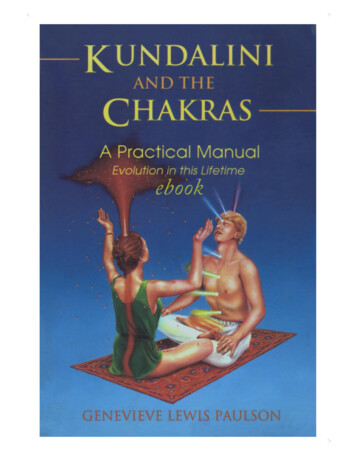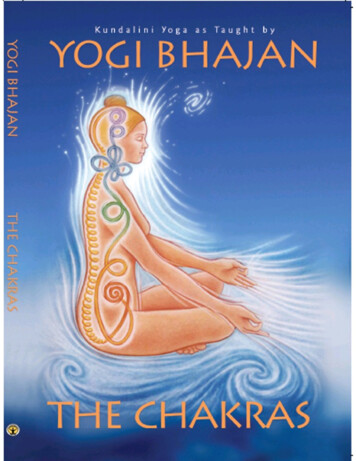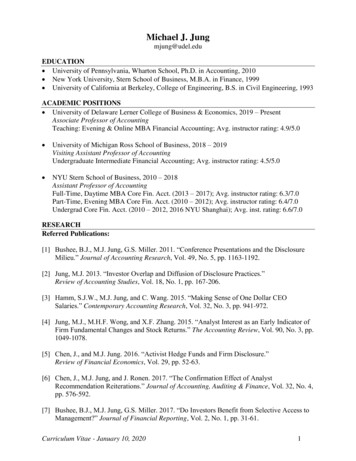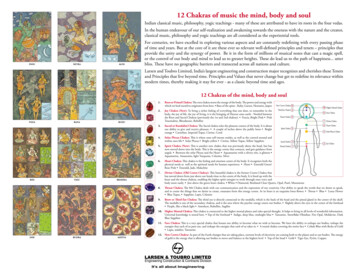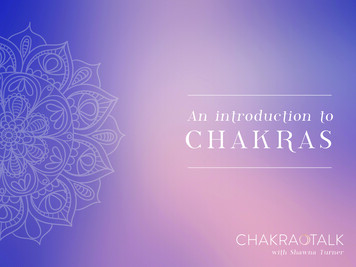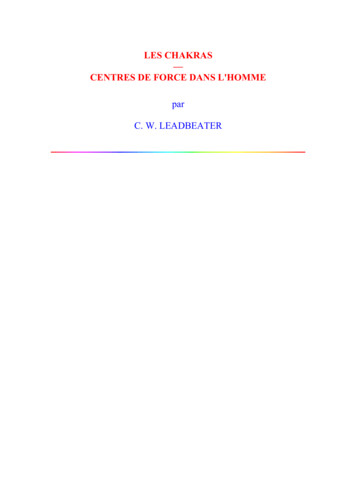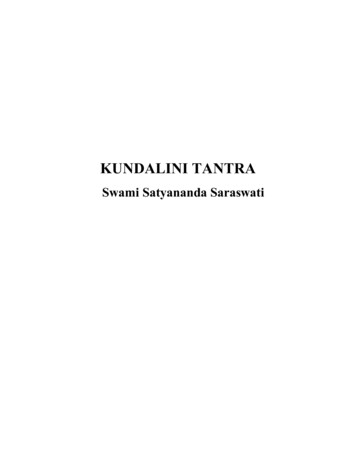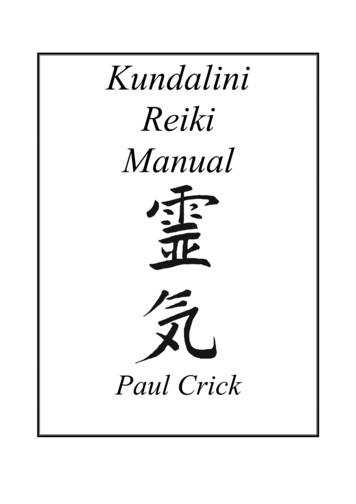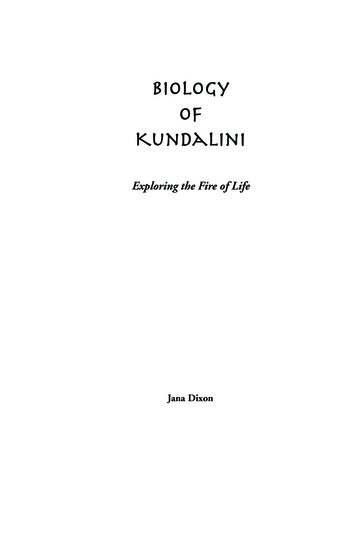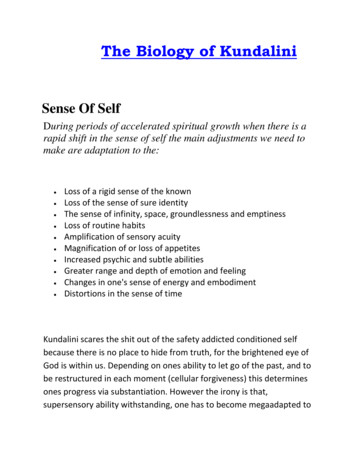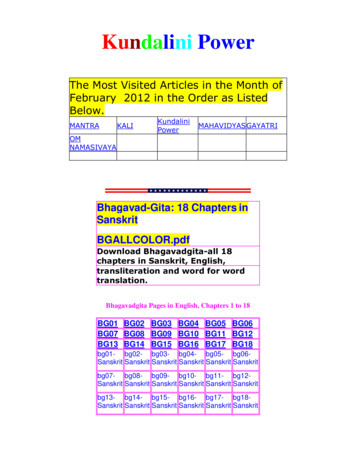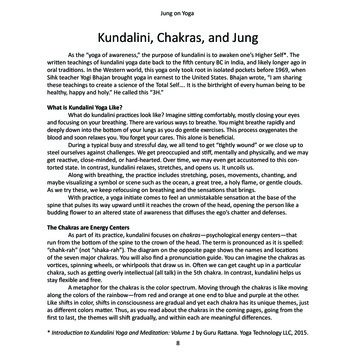
Transcription
Jung on YogaKundalini, Chakras, and JungAs the “yoga of awareness,” the purpose of kundalini is to awaken one’s Higher Self*. Thewritten teachings of kundalini yoga date back to the fifth century BC in India, and likely longer ago inoral traditions. In the Western world, this yoga only took root in isolated pockets before 1969, whenSihk teacher Yogi Bhajan brought yoga in earnest to the United States. Bhajan wrote, “I am sharingthese teachings to create a science of the Total Self . It is the birthright of every human being to behealthy, happy and holy.” He called this “3H.”What is Kundalini Yoga Like?What do kundalini practices look like? Imagine sitting comfortably, mostly closing your eyesand focusing on your breathing. There are various ways to breathe. You might breathe rapidly anddeeply down into the bottom of your lungs as you do gentle exercises. This process oxygenates theblood and soon relaxes you. You forget your cares. This alone is beneficial.During a typical busy and stressful day, we all tend to get “tightly wound” or we close up tosteel ourselves against challenges. We get preoccupied and stiff, mentally and physically, and we mayget reactive, close-minded, or hard-hearted. Over time, we may even get accustomed to this contorted state. In contrast, kundalini relaxes, stretches, and opens us. It uncoils us.Along with breathing, the practice includes stretching, poses, movements, chanting, andmaybe visualizing a symbol or scene such as the ocean, a great tree, a holy flame, or gentle clouds.As we try these, we keep refocusing on breathing and the sensations that brings.With practice, a yoga initiate comes to feel an unmistakable sensation at the base of thespine that pulses its way upward until it reaches the crown of the head, opening the person like abudding flower to an altered state of awareness that diffuses the ego’s chatter and defenses.The Chakras are Energy CentersAs part of its practice, kundalini focuses on chakras—psychological energy centers—thatrun from the bottom of the spine to the crown of the head. The term is pronounced as it is spelled:“chahk-rah” (not “shaka-rah”). The diagram on the opposite page shows the names and locationsof the seven major chakras. You will also find a pronunciation guide. You can imagine the chakras asvortices, spinning wheels, or whirlpools that draw us in. Often we can get caught up in a particularchakra, such as getting overly intellectual (all talk) in the 5th chakra. In contrast, kundalini helps usstay flexible and free.A metaphor for the chakras is the color spectrum. Moving through the chakras is like movingalong the colors of the rainbow—from red and orange at one end to blue and purple at the other.Like shifts in color, shifts in consciousness are gradual and yet each chakra has its unique themes, justas different colors matter. Thus, as you read about the chakras in the coming pages, going from thefirst to last, the themes will shift gradually, and within each are meaningful differences.* Introduction to Kundalini Yoga and Meditation: Volume 1 by Guru Rattana. Yoga Technology LLC, 2015.8
Dario Nardi“Heaven”#7. Crownsahasrāra(sah-has-RAH-rah)Unity & Awakening7NeocortexLimbic SystemPinealPituitaryThyroidThymusHeartLungsSolar minative6A/ 6B5#6A. Third Eyeājñā(ah-zh-nyah)Vision & Systems4#5. Throatvishuddha(vee-shood-dah)Speech & Reason32#4. Heartanāhata(ah-NAH-hah-tah)Balance & Empathy1“Ground”#6B. Third Eyeājñā(ah-zh-nyah)Psyche & Imagination#3. Solar Plexusmanipūra(mah-nee-POO-rah)Action & ProjectionMind EmbodiedThe nervous system is bothelectrical and hormonal. Itincludes the brain, nervesto the face, the spinal cord,autonomic nerves to all thebody’s glands such as theheart and gonads wherehormones are made, andalso peripheral nerves going out to the limbs.#2. er & Renewal#1. Rootmūlādhāra(MOO-lah-Ad-HAH-ra)Soil & SeedFigure 1: The chakras mirror activity along the entire nervous system9
Jung on YogaChakras as Biological CentersVarious traditions describe the chakras in their own ways, but they roughly map to physiologicalcenters in the body*. For example, the sacral chakra usually corresponds to the kidneys and gut—the element of water—and to digestion, cleansing, purging, and so forth in literal and metaphoricalsenses. In modern medical terms, the chakras likely mirror the activity of the autonomic nervoussystem, or ANS. The ANS runs throughout the torso, suffusing our organs (heart, lungs, etc.) and endocrine glands (gonads, adrenals, thyroid, etc.). Thus, chakras may correspond to biology.We can adjust our own bodily activity. For example, we can shift our breathing to alter ourheart rate and thus calm or excite ourselves. This can impact the whole ANS. We can hone our awareness of body sensations, such as what parts of us tighten or relax when we focus on certain thoughts.In these ways, we can tune in to our chakras. Kundalini yoga is a systematic way to do this.With patience, we may further learn to unblock chakras, proactively tap them as resources,and ideally bring them into alignment with each other and one’s core self, to live life fully and awake.Thus, chakra work via yoga is a daily practice toward spiritual growth. It differs from prayer butserves the same purpose to nurture a daily link to ourselves, other people, Nature, and the Divine.Major and Minor Chakras as Vibrational LevelsMost presentations cover seven chakras. Jung coveredsix in depth. Some who work with chakras cover eight to fifteenchakras, maybe more. Their reason: There are seven majorchakras plus five minor ones for twelve total along the body,plus one above and one below the body and one within— asabstract energy centers—for fifteen chakras total. Our palmsand soles, plus other points, can also be treated as chakras.Some people describe the chakras as vibrational levels,like a progression of notes on a piano. You can think of white keys as major chakras, as notes C, D, E, F,G, A, and B. In contrast, black keys are minor chakras. Of course, the notes have a sound such as Do, Re,and Mi for notes C, D, and E. In the same way, kundalini uses traditional sounds, such as LAM for the1st chakra and OM for the 7th chakra, to help a person get into experiencing each one.Chakras as GatewaysChakras tend to sit between major organs rather than map one-to-one. For example, the 2ndchakra sits between the sex organs and the gut, while the 6th chakra sits between the pituitary andpineal glands. Perhaps each chakra is a midpoint on a path? A path is where energy flows in the nervous system between organs. Thus, the chakra is like a gateway. If the gateway is pinched then energy flows poorly and a person feels discomfort or cut off below that point. A goal, then, of kundaliniexercises is to fully open gateways and pump energy along the path. Since our nervous system hastwo modes—fight-or-flight versus eat-or-sleep—each chakra might really be two gates.* The 8 Biotypes by Laura Power. http://www.biotype.net/types10
Dario NardiYour Core SelfVarious traditions, including kundalini yoga, describe an extra, all-encompassing chakra thatsurrounds a person like a bubble. You can see it as the big dotted circle in Figure 1 on page 9. This“aura” is more than a metaphor; it has a biological and psychological basis.Consider how you have a sense of personal social space. This space determines how closesomeone can get to you comfortably in casual conversation and such. You also have a perceptualfield—sight and sound—within which the brain is quietly alert to dangers; you become aware ofdisturbances only when something atypical is happening.You also radiate a purely physical field produced by your heart. This may surprise somepeople, but it is easily measured even with a smart phone app. The body’s systems—namely theheart and brain—generate an electromagnetic (EM) field. The heart’s power varies from 1 to 5 millivolts. About 1 meter out, your heart’s field will still measure 0.1 to 0.5 millivolts*. A sensitive devicecan pick up 1/100th that amount, and other peoples’ nervous systems can register it unconsciously.Some yoga masters as well as martial artists train to become aware of and actively directthis core energy by adjusting their breathing, heart rate, focus, and such. More typically, a kundalinistudent is generally aware of this field and does exercises to feel more harmonious.Your Turn: Breath of FireLet’s try a common kundalini breathing exercise called Breath of Fire. Start by sitting comfortably on the floor with your legs crossed. Sit on a cushion if you like. Close your eyes and mouth andkeeping them closed, focus your attention on your nose and navel. You may wish to place a hand onyour navel as a reference, at least at the start. Otherwise, rest your hands comfortably on your knees,palms up, with each index finger and thumb touching.Now, breathe in deeply through your nose until your gut (around your navel) distends. Thenlet your gut “pop” back into place as you release your breath, emptying your lungs through your nose.Forcefully push out the air, from the navel, drawing your navel toward your spineRepeat until you find a rhythm, and continue doing this for two minutes. You might use a timer.Ideally, you want to get to one breath per second—quick and forceful. You may need to work up to thatgoal starting with just thirty rapid, deep breaths. With practice, you can go longer.During the exercise, you may briefly feel urges to stop. You may even feel slight panic. Assuming you are of at least average health, this feeling is mostly psychological. Your mind is unused tobreathing this way. If you feel this urge, just note it and continue breathing, slowing down if needed,then speeding up again when you can. You will be fine.When you finish, assuming you worked up to a good speed, you will likely feel a rush, tingling,or pulsing in your head. You can focus on this feeling to enhance it. Also, your inner voice will likely bequiet for a time. Just sit and enjoy the sensation, perhaps noticing when your mind starts to get activeagain, and what that feels like. Or, pose a question to yourself and explore whatever comes up.* Field Intensity Power divided by 4 times 3.14 * the distance squared11
Jung on YogaKundalini Impacts the Body and BrainWe can measure the impact of kundalini yoga. Neuroscientists have monitored heart rate,brain activity, and such while people meditate. During a simple generic meditation to clear the mindand relax, heart rate and brain activity also relax. Moreover, people who are experienced meditatorssee greater reductions than those without experience.People who practice kundalini yoga tend to enjoy extra benefits because they focus on movingenergy. After just a few weeks of daily practice, they can show a brainwave pattern normally associatedwith a strong body connection. More than an empty mind, they show strong mind-body awareness.Body-mind awareness is important to notice and release stress, identify our emotions, and alterhabitual behavior. Movement in kundalini helps change our actions as well as thinking and feelings.During kundalini, when energy reaches the crown of the head, what happens? Is it special? Yesit is!* I asked a friend to help me find out. I used an EEG machine to observe his brain activity. Within afew minutes, he got into a strange trance-like state. From the outside, he was unresponsive. However,his brain activity said otherwise. His brain was active yet also even, like synchronized dancers.A chaoticbrain.becomesa zenbrain.or a rigidbrain.What was happening? His brain regions were in synch, working as one. Importantly, a brainnetwork associated with the ego was quiet. Also, brainwaves associated with body connection andhigh-level learning dominated. Other brainwaves linked to habitual activity and reward-and-punishment behavior were suppressed. This was not his normal baseline brain. Nor did it look like creativeflow or simple meditation. When he “woke up,” he was relaxed yet also talkative as he recounted lessons he had gleaned. He was unusually peaceful and joyous for quite a while after.With practice, people learn to carry kundalini’s benefits into everyday life. As part of this,their scope of consciousness, psychology, and behavior also start to shift. How is this possible?Yoga works because the body and mind link together. Rather than go into all the detailsnow, here is an example. Imagine, when you spot an attractive face, your visual system gets active toprocess that face a little differently than other faces. Older and newer brain regions activate. Consciously, you may focus on the person’s words or such. Unconsciously your ancient animal brain stayshooked for more primal reasons that arouse you. Signals go down through your whole nervous system to your organs. Your heart quickens and your stomach flutters. Moreover, when you daydreamlater, you can visualize that attractive person again in your mind’s eye to get much of the same effect.Thus, both experience and imagination are powerful. Because yoga exercises tap both of these, yogais powerful too. Part 3 explores the science of yoga in more detail.* Your Brain in Altered States [PDF PowerPoint] by Dario Nardi. http://www.Facebook.com/NeuroTypes12
Dario NardiEnter Dr. JungDr. Carl Gustav Jung (1875—1961) was a Swiss psychiatrist. Over his lifetime, he made manycontributions to psychology and other disciplines, including anthropology and religious studies. Heelaborated on many concepts you may have heard. There are archetypes, the collective unconscious,complexes, the persona, and the shadow, to name a few. In addition to a private practice, he visitedand studied many cultures in search of universal themes and processes. From all that, he offereddeep insights into human development. His insights continue to resonate with many people today.Of interest here, in the Fall of 1932 he gave
Kundalini, Chakras, and Jung As the “yoga of awareness,” the purpose of kundalini is to awaken one’s Higher Self*. The written teachings of kundalini yoga date back to the fifth century BC in India, and likely longer ago in oral traditions. In the Western world, this yoga only took root in isolated pockets before 1969, when Sihk teacher Yogi Bhajan brought yoga in earnest to the United .
